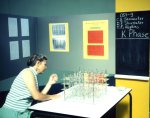
Clara Brink was born in 1921 in the small village of Rolde, Province of Drente, in the Netherlands. Her family situation was unusual for that time and place, as her father was a divorced, remarried minister of the Dutch Reformed Church. She had two half brothers from her father's first marriage to a minister's daughter whose brothers were also ministers and were strongly opposed to their sister's divorce.
Clara's mother was much younger than her father and was relatively uneducated, not having completed high school, but both Clara and her sister, who was two years older, were expected to be educated to the same level as their two half-brothers. She believes her father felt that it was only fair for the daughters to have all the same advantages that the boys had. He was quite liberal in his theology and in his views about the advancement of women, and he expected his daughters to go to the university when they completed high school.
Although Clara moved a number of times during her childhood, presumably due to her father's employment decisions, she remembers that school was interesting, especially science and math which were not subjects that seemed overly difficult or formidable to her. She and her sister traveled by train, and later by bus, to another town to attend high school doing some of their homework during the long ride to and from school. Her sister preceded her to the university majoring in biology.
Her father did not have the financial means to pay the costs of both daughters attending college, so fortunately for Clara she was awarded a much-coveted interest- free government loan, based on merit and need, to help pay for her college education. When she arrived at the University of Leiden in 1938 she declared a major in chemistry with a minor in physics. Six of the 20 students who were declared chemistry majors in her class were women. Only one of them, besides Clara, continued through to completion of her degree, and she became a high-school teacher. The others, later in life, practiced chemistry at an assistant level.


